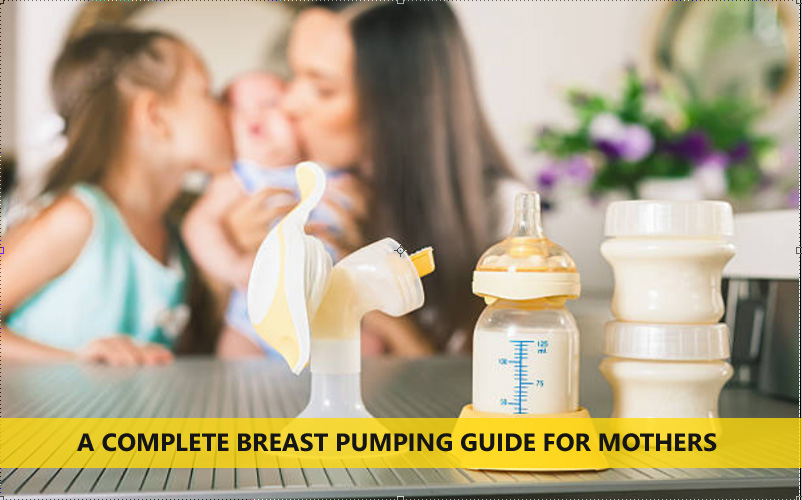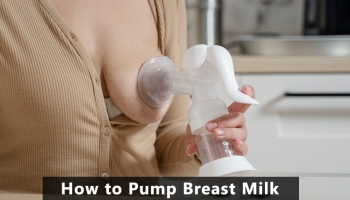
A breast pump is a mechanical device used to extract the breast milk by lactating mothers. A manual breast pump for mothers is powered by hand or foot movements. It can also be automatically powered by electricity. There are several reasons why women in the United States prefer a breast pump. They also use baby monitors along with, as they go out for work and leave their babies home with a caretaker. This article is a complete guide to a breast pump for mothers. It also elaborates on the use of baby monitors.
What Are The Benefits Of Breastfeeding?
Research has proved that breastfeeding, using a breast pump for mothers or otherwise, is incredibly beneficial for the health of both the mother and baby, especially when you breastfeed entirely for at least six months. Here are some excellent reasons why mothers should breastfeed.
For the baby:

- Breast milk of mothers is full of naturally occurring nutrition for the baby. It includes vitamins, proteins, and fats that provide everything to grow healthy and strong. Breast milk is more comfortable to digest for the baby than other dairies.
- Mothers’ breast milk fed to the baby through breast pump for mothers or manually, contains antibodies to aid the baby’s body fight illnesses, diarrhea, viruses, and bacteria. Breastfed babies are usually healthier and do not need medical treatment often. There is also a reduced risk of developing diabetes, obesity, asthma, and allergies.
For the mother:
- Oxytocin is a hormone that can help reduce uterine bleeding and help with returning the uterus to its normal size faster and giving birth. It is released in the mother’s body during breastfeeding.
- Whether fed through a breast pump for mothers or otherwise, breastfeeding reduces 500 calories of the mother’s body in a day. So, it also helps in weight loss.
- Breastfeeding saves money and, when done through the breast pump for mothers, helps save money. Baby monitors too help women observe their babies from afar when someone at home is feeding them.
How Does A Breast Pump Work?
The working process of breast pump for mothers is simple to understand. A breast pump imitates a nursing baby by mimicking its natural suckling method. A baby cannot apply constant pressure to the breast. The average baby sucks about 50 to 90 times per minute. It slows down once milk is released. An electric breast pump will create this cycle of suction and release by creating one pull per second once milk flow begins.

As breast milk is released from the breast, it gets collected in a storage container. The milk falls in the containers due to gravity. Breast pumps for mothers come with breast shields. They are funnel-shaped plastic parts that are placed over the nipple and areola to form a seal. The nipple is gently pulled into the flange tunnel to discharge milk. Be sure to have the correct flange size for successful breast pumping.
When Should Mothers Use A Breast Pump?
If you plan to provide breast milk for your baby and need to go to work, you will need a breast pump for mothers. Apart from breastfeeding, breast pumping can be beneficial for many other situations. It can relieve engorgement and prevent mastitis. A breast pump also allow you to render breast milk when taking care of your baby with no latching challenges or other complications.
Breast pumps for mothers give your partner or other family members the chance to feed the baby and experience the bonding, thereby enhancing it. Most of all, they help you build and maintain a sufficient milk supply.

Breast pumps for mothers allow you to run a quick job or participate in parties because you can be away from the baby for a few hours without skipping a feeding. Baby monitors help with it as you can observe your baby all the time, even when afar. These breast pumps make it easier to maintain your breast pumping goals by giving the capability to pump once you return to work. Several women enjoy the comfort of breast pumping on the go. Some breast pumps for mothers weigh less than a pound. The battery-powered pumps can be used to pump when no other power sources are accessible.
All you should know before breast pumping
There are few things you must know before using a breast pump for mothers. If the baby a full-term, healthy, breastfeeding one, you can wait a few weeks to start pumping and collecting breast milk. However, if the baby is preterm or ill and cannot breastfeed yet, you should pump as soon as possible after birth within one to six hours of delivery.
For primarily breastfeeding, use the breast pump for mothers in the morning. Many mothers get the most milk in the morning. You can pump between breastfeeding, either 30-60 minutes after nursing or at least one hour before breastfeeding. It leaves plenty of milk for feeding further. If the baby wants to breastfeed right after breast pumping, it’s alright to do so. But some babies are patient and will feed for a longer time to have milk.
Mothers who are solely breast pumping should plan to pump 8-10 times in 24 hours. Full milk production is 25-35 oz. per 24 hours. Once a mother has reached full milk production, she can maintain a schedule that continues producing about 25-35 oz. of breastmilk in 24 hours. Every mother and baby are different. Therefore, before using the breast pump for mothers, plan the pumping sessions around what goes best.
How To Use A Breast Pump?
If you’re planning to breastfeed your baby, before breastfeeding the baby using a breast pump for mothers, you must learn how to breast pump:

- Firstly, read the basics of breast pumping, and be sure to review your breast pump instructions. After that, find a quiet and comfortable place to sit. You may bring along a drink and a snack.
- Plugin the breast pump for mothers and wash your hands with soap and water. Set the pump kit and center the flanges atop your breast. Next, center the nipple in the flange opening, making an air seal. In case of double pumping, cup each flange to the breast. Keep the fingers beneath the flange and thumb on top. Use one arm over both the breasts. Make sure the seal of this breast pump for mothers is airtight.
- Finally, turn your pump on. Like a baby nursing at the breast, start with high speed and low suction until you see milk flow, set the pace to medium, and improve suction based on comfort level. Once milk flow drops, increase speed to high until the next let-down, then reduce to a breast pump’s mediocre speed for mothers.
How Long To Use The Breast Pump?
How much milk you should assume to pump will alter depending on factors like baby’s age, time of day, time since last feeding or pumping, pump type, practice with a breast pump for mothers, and stressed or relaxed mood. If you’re a mother and primarily breastfeed, on average, you can suppose more milk production in the morning hours. The volumes gradually decrease during the day into the evening. Breast milk volumes are subject to many factors. Most of all, each breast may produce a different amount of milk.
If you’re a mother and prefer exclusive pumping using a breast pump for mothers, you should try to keep full milk production of about 25-35 oz per 24 hours. It may take some time to accomplish this target, but it’s alright. Babies may need more milk from the bottle than when breastfeeding. A faster, more patterned flow of the bottle causes some babies to intake more milk than they require. A slow-flow bottle is ideal to avoid overfeeding. The next section discusses the use of baby monitors.
How To Use Baby Monitors?
Apart from the breast pump for mothers, baby monitors are handy for mothers. Simply put, a baby monitor is a system that parents use to monitor the sounds and movements of their baby remotely. When baby monitors were first invented, they could only record sound and no video footage. However, today these baby monitors can provide a live feed with some information about your baby’s room temperature and likewise.

Earlier baby monitors were like walkie talkies. They would be placed in the baby’s room and the other with the parents. But in this digital age, a baby monitor typically rests in the infant’s room, and the parents monitor the baby via their own mobile devices. Also, while someone is feeding your baby at home, you can monitor them from anywhere. Wireless baby monitors are recommended for infants below six months.
Conclusion
As discussed in the article, breast pump of mothers and baby monitors are important if you stay away from the home. Breastfeeding is great both for babies and mothers. There are many other reasons why you’d prefer a breast pump for breastfeeding. You can use both electric and manual breast pump. The way to operate and how long to use the pump, along with the usefulness of baby monitors is given above. So, if you are a mother, use a breast pump and baby monitors to make your life comfortable.





